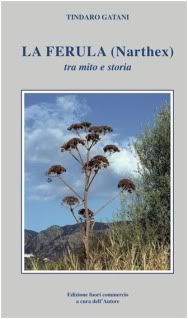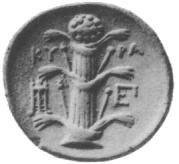

The esteemed and erudite librizzese TINDARO GATANI is a historian, author, researcher, teacher at the Casa d’Italia of Zurich, collaborator at the Central Library of Zurich (Zentralbibliothek), and since 2002 capo magazziniere of the Library’s Book Storage. In June of 1989, he was awarded the title of Cavaliere al Merito della Repubblica Italiana, and in 2007 Tindaro was named Commendatore dell'Ordine della Stella della Solidarietà Nazionale.
Tindaro's awards are many, as are the books he has published. Even though Tindaro has lived and worked in Zurich for over 40 years, his love for Librizzi has never waned. Several times a year he goes back to Librizzi to refresh his energies and find inspiration for his projects and research.
Please go to http://www.librizziacolori.eu/gatani/gatani_indice.htm,
and
http://www.librizziacolori.eu/gatani/commendatore/commemndatore.ht for more detailed information about his career and books..
Tindaro Gatani has just published his latest book, titled “LA FERULA (Narthex) tra mito e storia”. On November 12, 2010 Tindaro presented the new book at the Rotary Club in Patti, Sicily, and will be also presented it at the Liceo artistico of Zurich (Swizerland) on the 30th of November.
Ferula (from Latin ferula, “rod”) is a genus of about 170 species of flowering plants in the family Apiaceae, native to the Mediterranean region east to central Asia, it grows mostly in arid climates. The plant grows from one to four meters tall and the stems are stout and hollow. It has pretty yellow flowers, produced in large umbels. Some plants of this genus, especially F. communis are referred to as “giant fennel”, although they are not fennel in the strict sense.
Two species of Apiaceae are the Narthex and the Silphion (now pretty much extinct). The Silphion, in ancient times, was a universal medicinal remedy and was also used as an aphrodisiac. It grew only on the Cyrenaica peninsula and was so highly valued that its trade became the basis of wealth for the town of Cyrene. Coins from Cyrene show the stem of the Silphion along with the leaves.

In the early Roman imperial period the trade waned; Pliny reported that the last known stalk of Silphium found in Cyrenaica was given to the emperor Nero ‘as a curiosity’. .
The gummy resin of many species of Ferula is used not only for medicinal purposes but also as a culinary spice and vegetable. The Romans called the hollow light rod made from the plant a ferula and used it as walking sticks, splints, and for corporal punishment. The papal cross or ferula is an emblem of the papal court. As a cross, it was carried before the Pontiff in processions or was used by the Pope himself as his pastoral staff.
The Common Narthex (Ferula communis) is thought to be the plant Prometheus used to bring fire secretly from Hephaistos’ forge to humans. It also was used by the Menades and the other attendants of Dionysos, the god of wine and fertility. Dionysos was the grandson of Aphrodite, the goddess of love.
As I mentioned above the ferula was used for corporal punishment, especially in schools. A dictionary definition of ferule (English spelling) is ‘a schoolmaster’s rod, such as a cane, stick, or flat piece of wood, used in punishing children’. James Joyce vividly describes the use of the ferule in Jesuit schools in his novel “A Portrait of the Artist as a Young Man”.
I too have a story to tell about the use of the ferula during my elementary school years in a Librizzi school.
Several years ago a cousin who lives in Librizzi introduced me to Tindaro Gatani via emails. Tindaro and I have been emailing each other since we made each other’s acquaintance. Two summers ago I visited the town of my ancestors, Librizzi, and had the wonderful pleasure to personally meet Tindaro. I visited him at his home and quickly discovered that he is a bundle of energy and that his mind is working miles a minute planning his next research, book, conference, etc. He is also a genius!
Tindaro discussed with me his next project, the writing of a book on the ferula. He was fascinated with its ancient history and the myriad uses of the plant. He also gave me an actual demonstration of how the hollow cane was used to carry secret documents, seeds, and as a carrier of fire. I was fascinated.
During our chat I told him of my fella (Sicilian for ferula) experience from my elementary school days. He was very interested in my story and asked me to write the story for him so that he could include it in his projected book! And this is how my story is included in the book that Tindaro just published!
I have not seen the book yet but it will be in the mail in a day or two. Frankly I am looking forward to receiving and reading what I know will be a fascinating book.
Below is the original draft that I submitted to Tindaro about my ferula/fella experience. (Posted on this blog on Tuesday, August 11, 2009)

Photo by Carmelo Rifici
'MEMORIES FROM MY ELEMENTARY SCHOOL DAYS'
Memories of school days often flit through my mind, some are seen through rosy glasses and others are painfully bittersweet. One memory that has haunted me all of my life and which still causes me vivid pain is the incident with the FELLA.
I grew up in the beautiful little town of Librizzi where everyone knew everyone else, and almost everyone seemed to have a connection to one’s family. My teacher for the first five years of my schooling was my beloved Concettina Bisagni. She challenged me to learn, to ask questions, to be observant, and particularly to enjoy reading everything and anything imaginable. I remember reading every book in her school library as well as her private library. I was allowed to bring home any of her books that I chose to read, and I did so frequently. I remember reading late into the night, usually under the covers with the help of a flashlight.
The town offered only the first five years of schooling and if a student wanted to attend the Ginnasio , she had to travel by bus to the town of Patti. The trip took only about twenty minutes. My father’s plan was to send me to the Ginnasio but I had to wait a year so that I would travel with my brother who was a school year behind me. My father basically wanted my younger brother to guard me and to protect me from possible imaginary harm! Of course I could not just sit at home for a whole year while my brother finished his elementary schooling so my father decided that I would repeat fifth grade, this meant that I would be in the same classroom as my brother. No, I did not like this idea, in fact it was humiliating for me to have to ‘repeat’ a school year as if I had failed a grade. But I was not given a choice.
School children in Librizzi learned pretty quickly that there were consequences for misbehaving in the classroom. Discipline was commonly enforced by means of corporal punishment, usually in the form of a few taps on the open palm of the hand with a magic wand. Well not a magic wand but a “fella”, stick in English. Once a child felt the sting of the fella and saw the red imprint that it left on the palm she would work hard at not repeating the unaccepted behavior. If the teacher was particularly displeased she would hit hard enough to cause a welt to form on the palm. Signora Bisagni’s desk was usually decorated with a fella but to my recollection she never used it to punish me nor any of my classmates. Looking back I realize that she had ways, other than corporal punishment, to motivate her students to pay attention and to do their best. For me the motivational factor was the permission to take home her books to be read at my convenience.
It certainly was an eye opener when I entered the 5th grade for the second time and with a different teacher. It did not take long for me to discover that not all teachers are made of the same cloth. My brother’s elementary school teacher was indeed very different. He was extremely severe and the use of the fella on his students was frequent and forceful. At first I did not have any personal fears since he was my father’s cousin but soon I was to learn otherwise. To my great disillusionment the day arrived when my sweet memories of Signora Bisagni’s class were to be forever tainted by the memories of an incident beyond my control.
I recall that fateful day very clearly. The teacher asked a question and then called on a student for an answer but the correct answer eluded the unfortunate student. The teacher proceeded to ask a student and then another student and another student. He called every student in the class including my brother but no one was able to give an acceptable answer. Lastly he called on me. Well, Signora Bisagni had taught me well and I knew to always look at the footnotes. Yes, the answer to the question was in the footnotes! And so I gave the correct answer. Anticipating the dreaded use of the fella on my hands, I was greatly relieved to come up with the correct answer and certainly I was a little proud to be the star of the day. But my moment of educational pleasure was quickly dispelled. The teacher put the fella in my hands and commanded me to give each and every student in the class two ‘colpi della fella’. My reward became my classmate’s punishment! Worse, I had to hit my own brother. Halfheartedly and with tears in my eyes, I administered the punishment. When my brother’s turn to receive the bastonate arrived I tried to mitigate the damage by giving just little taps. The teacher who had supervised each and every hit with the ‘fella’ did not think that I had hit my brother hard enough and insisted that I do it again and with force.
Yes, my classmates were punished for not having the correct answer but I was forever punished for having the correct answer. I have never forgotten the pain that I felt while hitting my classmates and the agony felt when castigating my own brother. The humiliation, the pain, the vision of the domineering teacher, and the fella used as a disciplinary weapon, will always haunt me.
I became a teacher and honored my much admired Signora Bisagni by following her positive and wise methods to motivate my students.
August 31, 2009
I have just discovered that my beloved teacher's full name was Concettina Tollaro Bisagni, Tollaro being her maiden name.
I also discovered that she taught for 51 years! During her 50th year of teaching, the Italian Ministero della Publica Istruzione awarded her the Medaglia d'Oro, Gold Medal. To honor the teacher and her award, the town celebrated with a big party.
This new information was made available to me by Tindaro Gatani.